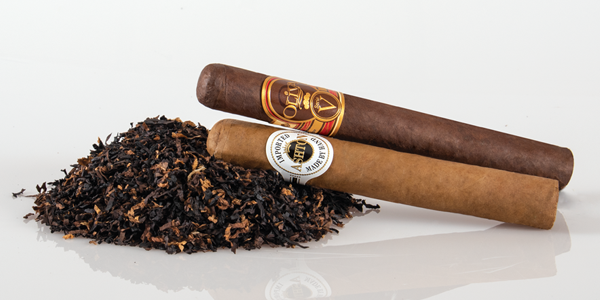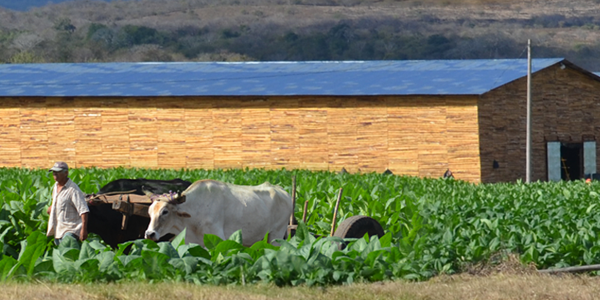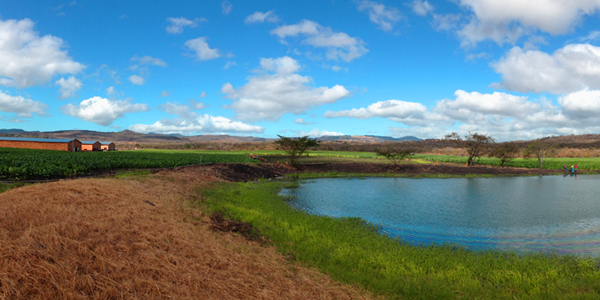Pipe Tobacco vs. Cigar Tobacco
Many premium cigar shops also carry pipes and pipe tobacco. Pipe smoking still enjoys a thriving audience, although less noticeable in public today than it was decades ago. Most pipe smokers indulge at home these days. A number of cigar lovers will also pick up a pipe on occasion and vice versa. Why smoke a pipe over a cigar, what’s the difference?
Well, there’s actually a pretty big difference between pipe and cigar smoking. The two often get lumped together because in both cases, you don’t inhale. Pipe tobacco, however, is typically fine cut or processed, while premium cigars are handcrafted from whole leaf tobaccos. The time and effort involved in smoking is different between pipes and cigars too.
Difference in Smoking
To enjoy a cigar, you simply need to cut it, light it, and ash it from time to time. Pipe smoking requires a little more maintenance than cigar smoking. First and foremost, you have to get a pipe. Most pipes designed for smoking tobacco are made of briar, corncob, or meerschaum. Briar is the most traditional and common material for making pipes. Briar is a dense root harvested in the Mediterranean Basin. It can me machined or carved by hand. Briar pipes range in cost from roughly $20 or $30 to several hundred or several thousands of dollars apiece. Corncob is inexpensive (think Popeye), and meerschaum is a soft, porous sea foam that is often carved with intricate designs.
Once you’ve got a pipe, it’s a matter of deciding on what kind of tobacco to smoke. Many will begin with an Aromatic, or sweeter, blend at first and those that prefer earthier, spicier flavors will move onto English tobaccos. Once you’ve chosen a tobacco, pack it into your pipe. Packing a pipe requires some know-how. You don’t want to pack your tobacco too loosely or too tightly. The density and moisture content in your tobacco will make a difference too. When the bowl is loaded and you’re ready to fire up, it’s best to use a soft flame lighter or matches. Don’t use your cigar torch on a pipe. The flame is way too hot and you’ll incinerate your tobacco and your pipe. Once the bowl is lit, control the air flow with a pipe tamper or your thumb. It’s important to regulate the oxygen to keep the bowl lit. Gently tap the tobacco down while you smoke. It takes patience and attention to smoke a pipe, but many enjoy the ritual.
Difference in Taste
Cigars are handmade to deliver a series of flavors that transition and generally intensify toward the end. The ring gauge and length of your cigar will also affect a cigar’s intensity. Thicker cigars burn cooler and more slowly. Longer cigars require more time for the profile to amplify, while shorter and thinner cigars deliver a greater concentration of flavor more quickly. The taste of a cigar relies heavily on the type of wrapper, binder, and filler leaves that are selected for the blend. Tasting notes of cedar, nuts, peppers, coffee beans, hickory, maple, cocoa, and many more are common. Cigars often fall into a creamy or a spicy spectrum.
Because pipe tobaccos are fine cut, the transition of taste is less deliberate. Below, we cover the differences between the two most common pipe tobaccos: Aromatic and English. The longer the bowl is burning, the hotter it gets. Smaller pipes heat up more quickly while larger, thicker bowls will burn cooler and more gradually. It’s important to let your pipe rest momentarily as you smoke it so that the bowl does not get too hot or cause a “bite” on your tongue. Also keep in mind, any tobaccos that have been smoked in your pipe previously will influence the taste of what you’re smoking now.
Difference in Cost
Some believe pipe smoking is more efficient, economically, than smoking cigars and vice versa. It boils down to how much you want to spend. You can spend $20 on a bundle of 20 cigars, or you can spend $30 or $40 or more on a single cigar. As long you enjoy the cigar you’re smoking during the time it takes to smoke, your money is well spent.
You can also get an inexpensive pipe for under $30, or you can spend well over $300 for a hand-carved brand, made by a famous pipe-maker. Many pipe smokers collect pipes and consider them works of art. When it comes to tobacco, you can enjoy cheaper brands for $2 or $3 per ounce, or you can spend $20, $30, $40, or more on rarer tins and limited edition blends. There are many brands to choose from, including Captain Black, Lane, Peter Stokkebye, Dunhill, Borkum Riff, Ashton, Mac Baren, and more.
Accessories like cutters, lighters, ashtrays, humidors, and pipe tampers don’t have to cost a fortune, but the sky’s the limit when you’re looking for exclusive, luxury branded accessories.
Difference in Tobaccos
Cigar Tobaccos
Premium cigars consist of binder, filler, and wrapper tobaccos. Many of these tobaccos are harvested in the Dominican Republic, Nicaragua, and Honduras. Wrapper leaves are grown in a number of additional regions, including the Connecticut River Valley, Ecuador, and the San Andrés Valley of Mexico. We outline a number of the most common plant varietals in our article on the many types of cigar tobacco. Every cigar is carefully crafted from a distinct recipe of tobaccos chosen by a master cigar-maker. These tobaccos are aged for long periods before and after the cigar is constructed.
Pipe Tobaccos
Pipe tobaccos fall into two broad classifications: Aromatic and English (or Non-aromatic). Aromatic tobaccos deliver sweeter, more sugary flavor profiles. They generally possess a higher moisture content than Non-aromatic tobaccos and they smell and taste nice. Aromatic tobaccos include a range of flavors like vanilla, whiskey, rum, cherry, chocolate, bourbon, and more. Aromatic brands like Captain Black have been widely distributed for many decades and, as a result, many people associate pipe smoking with the room notes these blends produce.
Non-aromatic, or English, tobaccos are earthy, woody, and spicy by comparison. Brands that are blended in an English style are created from tobaccos that are not sweet in nature. They can feature a peaty, mossy, peppery, or hearth-like taste and aroma. Generally speaking, English tobaccos are more of an acquired taste.
Both English and Aromatic blends are derived from a number of different tobaccos. There are 7 primary types of pipe tobacco:
Burley is found in many blends of pipe tobacco. There are little to trace amounts of natural sugar in Burley. As a result, it provides a dryer smoke, but it won’t burn too hot. Because it readily absorbs a number of flavorings, Burley is commonly used in Aromatic blends.
Cavendish is not a type of tobacco in an organic sense, but rather, it refers to tobaccos that have been cured in a special way. Cavendish is made from Virginia or Burley tobaccos that are heated, cured, and pressurized for several days or weeks to allow for an extended fermentation. At the end of the process, the tobaccos are almost black or dark brown in color. Cavendish is naturally sweet as well. Cavendish is often used in wide variety of Aromatic blends that feature vanilla, rum, cherry, chocolate, and other flavors.
Kentucky is a type of Burley tobacco that is fire-cured. Kentucky is not especially intense, but more on the aromatic and approachable side. Kentucky is cured on the stalk under controlled humidity in special barns that host a series of smoldering hardwood fires. The fires influence the curing process and give Kentucky its smoky and sweet character.
Latakia is named for a city in Syria. Latakia is an Oriental varietal of tobacco that hails from Cyprus and northern Syria. Latakia leaves are cured over aromatic woods and fragrant herbs that have been set on fire. Latakia adds exotic character to a number of blends. Its smoke is rich and dry with spicy, leathery, and herbaceous potential.
Oriental is grown in Turkey, the Balkans, and Russia. Oriental is also called “Turkish.” Oriental tobaccos produce a higher number of smaller leaves. It is a sun-cured tobacco and due to its nutty and sweet and sour taste, it’s often used in conjunction with Latakia in a number of English blends.
Perique originates from Burley tobaccos that have been fermented under extreme pressure in wooden barrels for at least one year. It is a dark, oily, peppery, and peaty in character. It is often used to complement Virginia tobaccos. Its flavor is strong and polarizing because it is a highly acidic tobacco. Perique can be traced back to the Choctaw Indians in the mid-1700s who inhabited what is now Louisiana. The Choctaws taught French colonist Pierre Chenet the technique of making Perique who passed it onto the Cajuns.
Virginia is the most popular tobacco varietal used in pipe smoking today. Virginia is also the mildest tobacco and contains the highest level of sugar. Because of this, its light, sweet taste is amenable to many. Virginia also burns easy and cool and is found in a number of flake and ribbon-cut tobaccos.
When you’re debating whether to pick up a pipe, we recommend starting with something affordable and find a tobacco you think you’ll like. After pack a bowl and start puffing, it won’t take long to figure out if you prefer a pipe over a cigar.







